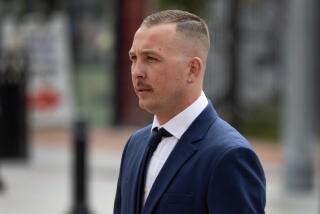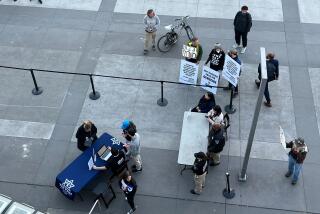For many at violent Berkeley rally, it wasn’t really about Trump or free speech: They came to make trouble

Conservative activists billed it as a “free speech” rally, but the demonstration in Berkeley quickly turned violent. (April 18, 2017) (Sign up for our free video newsletter here http://bit.ly/2n6VKPR)
When hundreds of activists on the left and the right converged here Saturday, things got ugly very quickly.
It was billed as a “free speech” rally by conservative activists, staged in one of America’s most liberal cities. But even before the event was set to begin, fists were flying and people were left bloodied. In the end, 21 were arrested and police confiscated an array of heavy sticks, knives, and Pepsi cans used as projectiles.
But what appeared to be a political event that devolved into violence was actually something more complex. The combatants on both sides were extremists who traveled from far and wide to make Berkeley their stage. Many freely admitted they were there to make trouble and that peaceful protest over President Trump and other issues really wasn’t their goal.
Much of the violence was captured on cellphone cameras and posted on social media, where each side offered supporters their narrative of what happened.
“People have to start throwing [things] in order to protect themselves,” said a feminist demonstrator who called herself Emily Rose as she and her bloodied companion caught their breath during the heart of Saturday’s protest.
Her face was masked in a black-and-red bandanna, her small hands encased in black gloves on which was strapped a vial of pepper spray. Moments later, she was punched in the face during a fight with Nathan Damigo, a Cal State Stanislaus student, Trump supporter and founder of white nationalist organization Identity Evropa.
Alt-right organizers and the anti-fascist groups that oppose them have battled online and in person for a year, fueled by Trump’s rise and the reaction to it. Both sides increasingly are coming to blows across the country, notably last year in Sacramento and a few weeks ago in Huntington Beach.
For reasons political and geographic, Berkeley has become a particularly common battleground.
Uncertainty and disillusionment in the current political climate has caused “a deeper tectonic shift within political extremes,” said criminal sociologist Brian Levin, director of the Center for the Study of Hate and Extremism at Cal State San Bernardino.
“They will glom themselves onto a tax day rally, a Trump rally, but there is a subgroup of extremists on both sides who are angling for a street battle,” Levin said. Replayed to their audiences on social media, “it goes viral.”

Pro-Trump rally in Berkeley
Saturday’s demonstration was advertised as a “Patriot’s Day” rally by the Liberty Revival Alliance, promoted on Facebook but for which there was no permit. It was held at the Martin Luther King Civic Center park, nearly adjacent to the city police station. Nearby bank ATMs were boarded up and the downtown Starbucks restaurants, attacked during earlier battles, were evacuated.
The confrontation began two hours before the event and consisted largely of pushing and shouting matches interlaced with brief clashes of violence, pepper spray assaults and explosives. The attendees represented a spectrum of neo-conservative and alt-right groups, including members of the para-military group Oath Keepers from as far away as Missouri, followers of the Proud Boys and those with openly anti-Semitic and neo-Nazi slogans.
Several hundred counter-demonstrators showed up, including feminists, and those who identified with By Any Means Necessary and various anti-fascist organizations that have a stronghold in the Bay. Large numbers of demonstrators wearing black masks massed under the red-and-black flags associated with socialist ideology.
Similar confrontations occurred in Berkeley in March and in February, when demonstrators were able to shut down a planned speech by now-defrocked far-right commentator Milo Yiannopoulos.
The extremist groups have been around for years.
“But now it’s burst out in multiple places,” said Heidi Beirich, director of the Intelligence Project for the Southern Poverty Law Center, an advocacy group that monitors and opposes hate crimes. “This is entirely new and there’s been a ton of it lately, and it seems to be out of control.”
The environment on college communities is especially heated, she said, and the center is advising student affiliates on how to avoid being drawn into confrontations she said are largely geared for generating publicity.
“Don’t even get near them,” she said. “Hold your own positive event, maybe on a different day.”
The escalation in Berkeley causes concern among some of the college town’s establishment.
“To the extent Berkeley is supposed to be representative (of liberal movements) we are being used,” said David Gottfried, part of a small group of local residents who set up an “Empathy Tent” at the edge of the demonstration and encouraged the shouting masses to consider listening and dialogue instead.
It wound up being hit by pepper spray.
“There was hardly anyone from Berkeley there, except of course the police,” said Gottfried, a self-employed artist who, at 58, is roughly twice the age of most of the combatants ignoring the tray of chocolates he held out.
Gottfried worried that the product of the day would be an escalation of extremism.
Tim Mueller, 50, was the lone farmers market merchant who kept his tables of organic vegetables and beef open during the Saturday demonstrations as an act of defiance and political statement.
“I’m not willing to cede the space to… to this,” he said, munching on a carrot as explosives went off down the street. “It’s testosterone poisoning on both sides. They come here to just start a fight.”
Nearby, AJ Alegria, 31, of Sacramento ran from the crowd, blood streaming from his face, blinded by pepper spray.
“Ultimately the goal is to stop this and get back to dialogue,” he said. “I thought we could pacify them, stop them.” He admitted to using his fists, “after they hit first.”
Ultimately the goal is to stop this and get back to dialogue. I thought we could pacify them, stop them.
— AJ Alegria, 31, of Sacramento
Damigo, the alt-right leader seen in videos and photos punching Emily Rose, was not among those arrested by Berkeley police. His Identity Evropa recruitment activities at Cal State Stanislaus have raised previous concerns. Campus administrators released a statement this week saying they were investigating his role in the Berkeley brawl.
“The university has zero tolerance for the use of violence and we will take all of the necessary legal and disciplinary measures to ensure that all students and everyone on campus have a safe and secure environment,” university President Ellen Junn said.
Damigo could not be reached for comment Monday.
Most arrested Saturday were from the Bay Area, but some accused of battery came from Palmdale and Huntington Beach, according to a list police released Monday.
Among them was Kyle Chapman, who was arrested on a warrant for an alleged assault at a violent protest in March. When officers grabbed Chapman from the crowd and cuffed him, alt-right blogger “Baked Alaska” launched a livestream feed denouncing the arrest.
When a reporter asked him to confirm what he had just witnessed, Baked Alaska bounced around and heartily announced he was about to become the subject of a “hit piece” by the “fake news media.”
There was heavy police presence throughout the day. At times, officers formed a barrier between the opposing, shouting sides; at others, they moved to the edges to contain or corral the crowd.
As the day wore on, police officers arrived from nearby Oakland. Berkeley Officer Jenn Coats said the department trying to keep up.
“With each situation we learn and progress with our tactics,” she said. “Hopefully things will be better as we go forward…. People have the freedom to express themselves.”
Both sides tried to engage police in their fights, complaining loudly when officers stood back, even as many officers filmed the altercations with their own cameras. However, police waded in to make arrests when the most violent fighting broke out.
In late afternoon, when families with children arrived downtown and Berkeley’s fine-dining scene kicked into gear, they marched in with shields and summarily sent the tired demonstrators home.
A half dozen demonstrators remained, standing on a downtown Berkeley street corner, shouting at one another as evening dinner patrons strolled arm-in-arm around and past them.
To read the article in Spanish, click here
Twitter: @paigestjohn
Times staff writer Hailey Branson-Potts contributed to this report.
ALSO
‘Caravan Against Fear’ makes a stop in downtown Los Angeles
They’re not lovin’ it: L.A. school resolution would ban McDonald’s school fundraisers
Victim of sexual misconduct by UC Berkeley law school dean criticizes campus settlement
More to Read
Start your day right
Sign up for Essential California for news, features and recommendations from the L.A. Times and beyond in your inbox six days a week.
You may occasionally receive promotional content from the Los Angeles Times.







